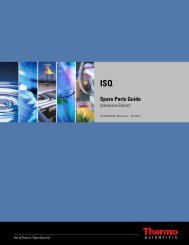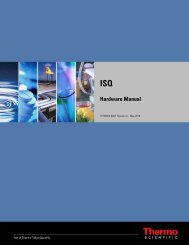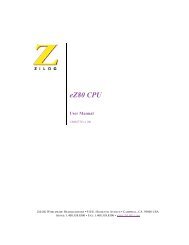ISQ User Guide - Write Frame of Mind
ISQ User Guide - Write Frame of Mind
ISQ User Guide - Write Frame of Mind
You also want an ePaper? Increase the reach of your titles
YUMPU automatically turns print PDFs into web optimized ePapers that Google loves.
7 Optimizing Your Method<br />
Modifying an Automatic Tune<br />
• Initial Detector Gain—Select this option to set the true gain <strong>of</strong> the electron<br />
multiplier. The gain is the number <strong>of</strong> electrons generated for every ion that strikes the<br />
detector. This is typically set between 1 x10 5 and 3x10 5 electrons per ion. Gains<br />
larger than this will generate more electrons per ion, but both the analyte ion and the<br />
noise ion signals will be larger. The detectivity <strong>of</strong> the instrument will be the same.<br />
You can also tune to lower gain values, which decreases the signal strength. Lower<br />
values also increase the chance that an ion will not be detected. As the electron<br />
multiplier ages, the voltage required for a given gain will increase. Depending on your<br />
sample load and if your system is leak tight (oxygen is bad for the detector), you<br />
should not have to perform this tune very <strong>of</strong>ten.<br />
• Tune Detector—Select this checkbox to tune the detector.<br />
• Adjust Detector Sensitivity—Select this checkbox to tune the detector to generate a<br />
consistent area count <strong>of</strong> a calibration gas ion for the tune report. Because the intensity<br />
<strong>of</strong> the cal gas varies depending on the atmospheric pressure and temperature <strong>of</strong> the<br />
lab, this option will result in larger variation in the analytical runs.<br />
– Mass—Use this pull-down menu to select the calibration gas mass you want to<br />
use.<br />
– Intensity—Use this field to enter the intensity you want to see on the tune<br />
report.<br />
12. Click the Diagnostics tab and select a test to confirm the operational ability <strong>of</strong> the <strong>ISQ</strong>.<br />
Thermo Scientific <strong>ISQ</strong> <strong>User</strong> <strong>Guide</strong> 87






